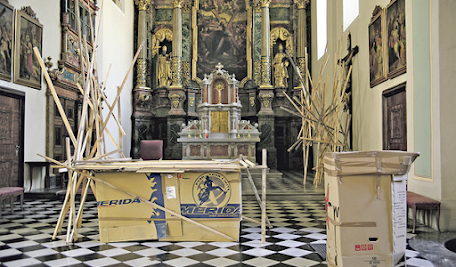Second Vatican Council finally produces Worst Altar in World
Creating space for the soul
There has always been
art in the church. The confrontation
with art of our time creates friction, sometimes disturbs, irritates. Why it is necessary was the subject of the
study day "Why art in the church? - with Bishop Hermann Glettler and 60
participants.
"What kind of nonsense have they put up there?" a
church visitor asked Bishop Hermann Glettler when he was still parish priest in
Graz-St. Andrä. Flowers made of concrete
in the church: "Such a coarseness," she said shaking her head. Bishop Hermann Glettler talks about this
encounter in the church. He smiles and
his eyes light up: "Yes, art is also a placeholder for nonsense. For what doesn't have to be but can be. It is first and foremost about encounter and
processes that are set in motion and not about the work of art," he says
at the study day of the Institute for Pastoral Continuing Education in the Linz
seminary. For more than ten years, as a parish priest and curator, he promoted
encounters with art in his parish and learned a lot himself through it.
Disturbance
A shrouded altar and ambo in cardboard from a hermit who had
been living and working silently in the organ loft for 40 days, a wooden nave
in the middle of the church space that made the question of how to deal with
refugees impossible to miss, a glass window with an entrance door. Useless and
yet like a gateway to heaven, as one child thought. - These are just a few of the examples he made
possible with the art dialogue in St. Andrä. Contemporary art breaks with familiar images,
expectations and attitudes. It disrupts the usual routine, and that is
precisely where its strength lies. "People have to function today. Always and everywhere. Art relieves, irritates, creates free spaces,
creates spaces of curiosity, spaces where the soul can breathe," is how
Glettler describes his approach. In other words: "Art and the Church try
to counteract the banalisation of life and the fatal pressure of the total
economisation of our lives. This happens in and beyond familiar church spaces
and always has a future where church and art take each other seriously as
self-determined partners."
Quality
Art can be temporary, as in many events in Graz-St. Andrä,
or it can take the form of artistic designs that leave their mark on spaces and
places for decades. In the Diocese of
Linz, more than 200 sacred spaces have been redesigned by artists in the last
15 years, either by direct commission or following competitions; the Art
Department of the Diocese of Linz is the point of contact here. "I
congratulate them, the Diocese of Linz is one step ahead," says Glettler
appreciatively. The churches have always paid attention to quality. It is
important to trust the advice of the experts: "What is art is determined
by the experts and not by the parish church council. One becomes an expert through a lot of
"looking at art", years of experience, through comparisons and
encounters with artists. The benefits of working with experts are impressively
demonstrated on this study day by two practical examples: the redesign of the
funeral chapel in Pabneukirchen by Alois Mosbacher and the Parish Church of
Wels-Heilige Familie by Gerold Tagwerker.
Encounter
Bishop Glettler warns against seeing art as a panacea for
life's frustrations and states of exhaustion, nor is it a superficial
decoration for a bourgeois lifestyle: "Contemporary art is to a large
extent a commodity, a speculative good and a capital investment," Glettler
explains soberly. What is needed here is the discernment of spirits. - First
and foremost, in the concrete social areas of life, it is about encounter,
about building resilient relationships, about closeness and comfort, about
solidarity and pastoral care. "It
is not about furnishing church spaces with artefacts." That has its place
and its meaning. Old and new art - both
have their value and create identity.
"But an open-mindedness of the church for the culture
of the time is simply an imperative of hospitality," says Glettler.
Contemporary art, he said, is often about setting social processes in motion,
redeveloping a neighbourhood and creating networks to protect weaker members.
That the church is there for all, also for the "others", for
marginalised groups and those far from the church, this idea of universality is
also affirmed by Glettler in the evening as a speaker at the "Thomas
Academy".
Vitality
Art can help to keep this "more of life" in mind,
and brings a plus in vitality and intensity, also for one's own congregation -
and one's own life. "I am grateful for the encounters with artists",
says Bishop Hermann Glettler, "for the more vitality, alertness and
attention". And you can feel that.
1st picture
Consciously missing everything. This was the programme of Christian
Eisenberger in 2007, who lived and worked in the organ loft in the parish
church of St. Andrä for 40 days during Lent and kept silent. During this time he covered the altar and ambo
with packing cardboard and wooden poles (picture) - a new interpretation of the
Lenten cloth. However, Bishop Hermann
Glettler generally warns against too much interpretation: "I sometimes
feel the mandate to have to protect the secular, the unwieldy and
incomprehensible in art from the all too well-intentioned grasp of overzealous
spiritual interpretations."










.jpeg)

Comments